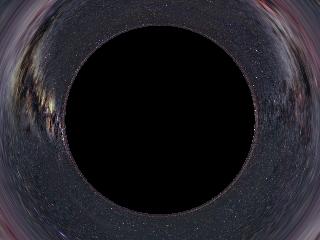Relativity visualized


Computer simulated images show views of the night sky as seen from positions close to the horizon of a black hole.
The descent towards a black hole is recorded with three cameras: No. 1 is looking forwards, i.e., straight into the black hole, No. 2 is directed sideways and No. 3 is looking backwards in the direction exactly opposite to No. 1. Each camera has a horizontal opening angle of 90 degrees so that together they give a panoramic view over 270 degrees of their surroundings.
The images are taken while the cameras are at rest with respect to the black hole. They are labelled with the Schwarzschild radial coordinate, r, of the camera position which is given in units of the Schwarzschild radius, rs, of the black hole. The optical effects depend on the ratio r/rs only.
To keep a camera at a constant radial coordinate it must be accelerated. The required acceleration, a, is noted along with the position and is expressed in terms of the gravitational acceleration at sea level on earth, g. It is calculated for a 10 solar mass black hole. It is possible to have the same optical effects with a much smaller acceleration; this simply requires a much more massive black hole. In order to remain at r=1.005 rs with an acceleration of merely 1 g, the black hole would have to have 20 trillion (20 million millions) solar masses, i.e. about 10 million times the mass of the black hole in the center of the Galaxy.
NOTE: When a camera that sits close to a black hole receives radiation emitted by a faraway star, this radiation is blueshifted. I.e. the visible radiation recorded by the camera was originally emitted in the infrared. This gravitational change in wavelength exceeds 10% for r smaller than 5 Schwarzschild radii. A more realistic impression of the night sky as seen from nearby a black hole thus requires the use of infrared all-sky images which are then blue-shifted and intensity-scaled in the appropriate way.
r = 100 rs, a = 15 million g r = 20 rs, a = 400 million g r = 4.5 rs, a = 9 billion (9000 million) g r = 2.5 rs, a = 30 billion g r = 1.5 rs (photon sphere), a = 100 billion g r = 1.2 rs, a = 250 billion g r = 1.05 rs, a = 650 billion g r = 1.005 rs, a = 2000 billion gClick on an image for a higher resolution version (640 x 512, 20 to 90 kB).
Diagrams of photon paths near a black hole
illustrate how the images shown above are formed.
1. Light deflection near a black hole - overview
2. Multiple images
3. "Engulfed" by a black hole while still outside the event horizon
The images and diagrams may be used for non-commercial purposes provided credit is given to the author and the institutions concerned:
Ute Kraus,
Max-Planck-Institut für Gravitationsphysik, Golm, and
Theoretische Astrophysik, Universität Tübingen
https://www.spacetimetravel.org
These images use Axel Mellinger's All-Sky Milky-Way Panorama,
see https://www.milkywaysky.com/![]() .
.
Contact: Would you like to send us a message?